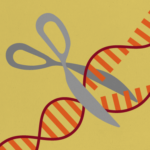CRISPR-Cas9 is a revolutionary genome editing technology with a host of potential biotechnology applications and also, the subject of three-year long litigation between leading research institutes. During the period of 2011 to 2012, two research teams, one at the University of California-Berkeley and the other at the Harvard and Massachusetts Institute of Technology-affiliated Broad Institute, were researching the same mechanism simultaneously yet separately. Finally, by the end of 2012, Dr. Jennifer Doudna of UC Berkeley published her findings on how to transform CRISPR from a natural bacterial mechanism into a laboratory-based genome editing tool. In 2013, Feng Zhang of the Broad Institute published a paper outlining the CRISPR process as applied to eukaryotic cells. Then, in April 2014, The Broad Institute received the first of several issued patents for the mammalian use of CRISPR.
While the Broad Institute’s patent applications were not the first CRISPR-related applications to be filed, these were the first that described actual experimental data in mammals. Doudna’s disclosure instead focused on CRISPR in cell-free systems, such as bacterial systems in test tubes. Indeed, Doudna’s invention was not directed to genome editing in eukaryotic cells. The Broad Institute’s issued patents, on the other hand, deal with genome editing in eukaryotic cells, focusing more particularly on its usage in human and mouse cells. This patent granted by the United States Patent and Trademark Office thereby awarded the Broad Institute the exclusive rights to use the CRISPR-Cas9 for eukaryotic cell-editing methods.
Derived from a protein found in Streptococcus bacteria, CRISPR-Cas9 is a gene-editing tool capable of making precise cuts and rearranging viral DNA. CRISPR-Cas9 renders possible a variety of advancements in fields such as medicine, biology, and agriculture. In particular, CRISPR-Cas9 may potentially help to cure genetic diseases such as Huntington’s disease, sickle cell anemia, and cystic fibrosis. Moreover, CRISPR-Cas9 could also produce bespoke bacteria, engineer animal chimeras, and make foods more plentiful and safer. As a result, CRISPR applications in eukaryotic cells, including plant, human, and animal, hold the greatest potential for industry and commercial purposes. It is, therefore, understandable that UC-Berkeley and the Broad Institute would controvert who deserves credit for realizing the CRISPR system in mammalian cells.
Following the issuance of the Broad’s first CRISPR-related patent, Doudna and her collaborators at UC-Berkeley appealed the decision by the patent office. Doudna did so by filing an interference proceeding, which is aimed at determining the priority of multiple patent applications. The United States, and all other countries, utilizes a first-to-file patent system, wherein the right to the grant of a patent for a given invention lies with the first person to file a patent application for protection of that invention, regardless of the date of actual invention. However, at the time the Broad Institute and UC-Berkeley filed their respective applications on CRISPR, the United States followed a first-to-invent system. Invention was defined as (1) conception of the invention and (2) reduction to practice of the invention. An interference proceeding, therefore, determines which party, out of two claimed inventors, is the earlier inventor of the claimed invention. At such a proceeding, the USPTO reviews evidence of conception and reduction to practice.
UC-Berkeley’s position is that Doudna and her team invented the system and that UC-Berkeley’s patents relating to CRISPR overlap the Broad’s patents. Due to this overlap, Berkeley contends that it is the rightful owner of the Broad’s issued patents on CRISPR. In February 2017, the United States Patent Trial and Appeal Board disagreed by ruling that the two patents owned respectively by UC-Berkeley and the Broad Institute applied to different subjects and therefore, do not interfere with one another. UC-Berkeley thereafter appealed that ruling, arguing the wrong standard for obviousness was applied by the Board. Obviousness is a general patentability requirement according to which an invention should be sufficiently inventive, or “non-obvious,” in order to receive patent protection. UC researchers argued it was obvious to test the CRISPR system in mammalian cells and that the Board erred in finding that merely because there was no guarantee the eukaryotic experiment would work, the Broad Institute had satisfied the obviousness standard.
On Monday, the United States Court of Appeal for the Federal Circuit affirmed the Board’s termination of the interference proceeding. The Federal Circuit found that while the two patents at issue do overlap somewhat, the claims subject to the interference proceeding were separately patentable. The decision did not address, however, who invented the specific application of CRISPR-Cas9 in eukaryotic cells nor whether the patents held by the Broad Institute or UC-Berkeley are valid. Indeed, other proceedings may later establish that UC-Berkeley is the actual inventor of the CRISPR-Cas9 system in eukaryotic cells. While the Broad Institute has reflected on this litigation in stating “it is time for all institutions to move beyond litigation,” UC-Berkeley contends it will be “evaluating further litigation options.” Regardless, per the recent result, both parties remain free to exploit their respective patents and applications.

